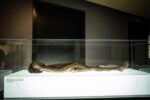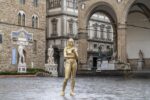Bethan Huws – The Ash and the Elm
 (1200x1200).jpg)
Al centro della mostra un olmo, un frassino e una targa incisa con una proposizione di Ludwig Wittgenstein.
Comunicato stampa
Vistamare is pleased to present The Ash and the Elm, Bethan Huws’ first solo show in Milan.
At the centre of the exhibition are two living trees, an elm and an ash, and an engraved plaque with a numbered proposition by Ludwig Wittgenstein in which the philosopher describes being out on a walk with a friend and mistakes an elm for an ash; his companion corrects him, and he replies, “I always meant ash when I said elm.” Huws continues her exploration on meaning with the work Trombone, 2022, a three-metre-long paperclip positioned on the floor. It’s a word game, inspired by the fact that a paperclip in French is called a ‘trombone’ in analogy to the musical instrument.
Long interested in Duchamp, Huws is likewise captivated by ideograms, symbols and ready-mades. Carotte de Tabac, 2022, installed in the right hand room, reproduces the sign that hangs outside tobacconists in France. According to Huws there are many tobacco related items in Duchamp’s work, “which in his system, metonymically represent the spirit or mind”. This black-and-white neon sculpture echoes the film The Chocolate Bar, 2006, projected in the left hand room. The film is divided into two asymmetrical parts, and ironically comments on the communication gap between two characters – both of them played by the same actor – and between Welsh and French culture, with allusions to the history of conceptual art and surrealism.
Completing the exhibition is a new series of the word vitrines that Huws first began making in 1999, representing different ways of displaying a text. The vitrines, which are wall-hung like paintings, are those typically used in offices to communicate information before the computer age. In her practice Huws successfully combines very different elements from a wide range of theoretical studies, which dialogue with one another. Like in After Lucas Cranach (detail) or like the surface of the moon, 2018, where a particular from the German Renaissance artists’ paintings provides Huws with a starting point from which to conjure up an abstract space, redolent of moonscapes.
---------
BETHAN HUWS
The Ash and the Elm
Opening 6 giugno, 2022, 19 – 21
7 giugno - 29 luglio, 2022
Vistamare è lieta di presentare The Ash and the Elm, la prima personale a Milano dell’artista gallese Bethan Huws.
Al centro della mostra un olmo, un frassino e una targa incisa con una proposizione di Ludwig Wittgenstein. In questo breve testo, il filosofo esce per una passeggiata con un amico e scambia un olmo per un frassino; il suo compagno lo corregge e lui risponde: “Ho sempre avuto in mente il frassino quando invece ho detto olmo”.
Nella poetica dell’equivoco, Huws continua la sua indagine sul linguaggio con l’opera a terra Trombone, 2022. Un fermaglio di tre metri, dalle dimensioni grottesche, con cui l’artista compie un gioco di parole con l’etimologia del termine francese “trombone”, analogo allo strumento musicale a fiato.
Interessata da sempre a Duchamp come padre intellettuale dell’arte concettuale, l’artista è anch’essa affascinata dagli ideogrammi, dai simboli, e dai ready made. Nella sala di destra, Carotte de Tabac, 2022 riprende l’insegna delle tabaccherie francesi e rappresenta nell’opera di Duchamp lo spirito o la mente. Realizzata in neon bianco e nero, la scultura fa da eco al film The Chocolate Bar, 2006, proiettato nella sala di sinistra. Il film, diviso in due parti asimmetriche, ironizza sulla difficoltà di comunicazione tra due personaggi, interpretati dallo stesso attore tra cultura gallese e francese, con rimandi alla storia dell’arte concettuale e al surrealismo.
Completano la mostra una nuova serie di vetrine testuali, che iniziate da Huws nel 1999, rappresentano modi differenti di esibire un testo. Le vetrine presentate su pareti come dipinti, sono tipicamente utilizzate in contesti amministrativi per comunicare informazioni al pubblico. Huws trae ispirazione dalla storia dell’arte e riesce a riunire gli aspetti più diversi di molti studi in teorie e opere che trovano un dialogo nella disposizione dei vari elementi che le compongono. In After Lucas Cranach (detail) or like the surface of the moon, 2019 un dettaglio di un dipinto del pittore del rinascimento tedesco fornisce all’artista lo spunto per evocare uno spazio astratto, reminiscenza di un paesaggio lunare.



